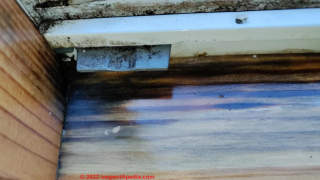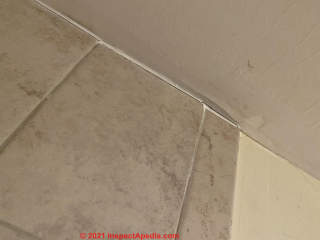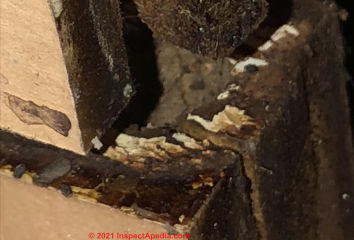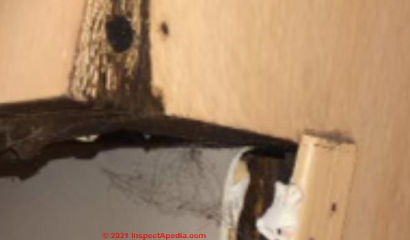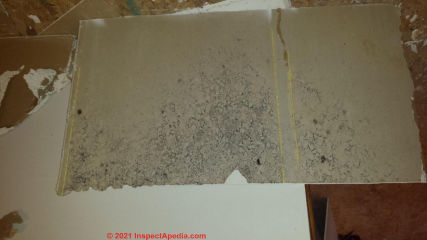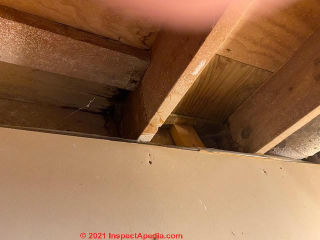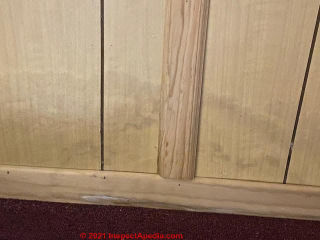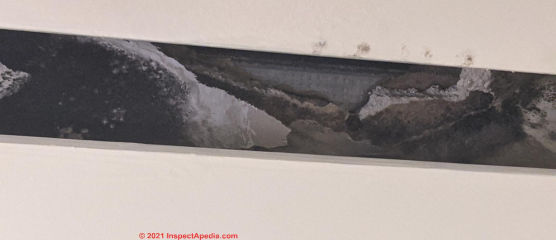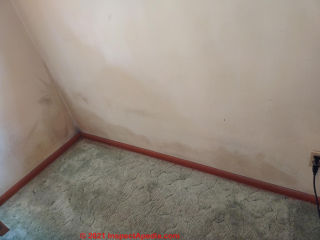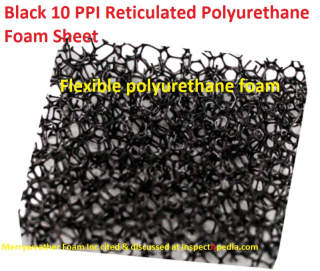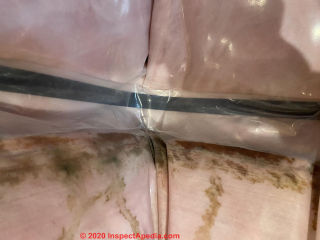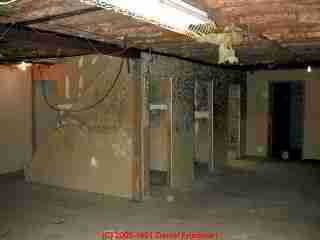 Mold Identification FAQs
Mold Identification FAQs
- POST a QUESTION or COMMENT about what black mold, "toxic black mold" or plain cosmetic (harmless black mold) looks like in buildings, including homes, offices, and even in boats, cars, trucks, and mobile homes.
Questions & answers on how to recognize mold contamination in buildings:
What does building mold look like? These mold recognition FAQs also include references to an online reference photo library of various kinds and colors of mold as it is found growing in buildings.
Our pictures of mold on building surfaces help you recognize mold in buildings, recognize probably-cosmetic mold, and recognize stuff that is not mold and does not need to be tested.
InspectAPedia tolerates no conflicts of interest. We have no relationship with advertisers, products, or services discussed at this website.
- Daniel Friedman, Publisher/Editor/Author - See WHO ARE WE?
FAQs on how to Identify Mold in Buildings
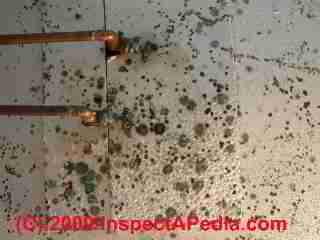 6 atlases or indices of building mold
6 atlases or indices of building mold
- MOLD ATLAS & PARTICLES INDEX - A-to-Z Mold Atlas of Indoor Clinical Mold, Pathogens, Allergens & Other Indoor Particles
- MOLD APPEARANCE - WHAT MOLD LOOKS LIKE - What Does Black or Dark Indoor Mold Look Like? Black Mold spores in the Home - a Photo ID Library. What toxic black mold or other indoor mold looks like in buildings.
- MOLD GROWTH on SURFACES, PHOTOS - What Does Mold Look Like on Various Materials & Surfaces? An extensive photographic guide to mold as it is found growing on various building materials & surfaces.
Also see MOLD GROWTH on SURFACES, TABLE OF - a Table of Kinds of Mold Growth Found on Building Surfaces, lists mold genera/species most often found on specific building surfaces, materials, or contents - MOLD in the PETRI DISH, PHOTOS - Photographs of Mold Growing on Petri Dishes or Mold Culture Plates or Settlement Plates
- MOLD by MICROSCOPE - Mold spores under the Microscope - a Photo ID Library for detection and identification of toxic or other mold
- MOLD RELATED ILLNESS SYMPTOMS - Mold Related Illness: Index of Symptoms. Readers should not rely on this document for medical diagnosis and instead should consult with their physician or with a specialist such as a medical toxicologist
The building mold questions and answers found below were posted originally
at MOLD APPEARANCE - WHAT MOLD LOOKS LIKE
On 2021-11-20 by Inspectapedia Com Moderator - window condensate may result in mold
@Anonymous,
In general when I see any dark stains on wood caused by water I believe that technically it's usually mold or fungal damage.
That's not to say that there is a harmful mold reservoir or health hazard. You would need to investigate further in the wall cavity.
On 2021-11-20 by Anonymous
Is this mold? Recently discovered condensation build up around my windows
On 2021-10-14 by inspectapedia.com.moderator (mod) - is this mold?
We could not see mold in your photo with certainty, though there is some evidence of water damage to what looks like drywall along a tile surface. Sorry but I'm not sure what we're examining. That makes offering a clear answer more-difficult.
Perhaps a sharper, closer, or better-lit photo would let me say that I can recognize mold growth.
Also tell me what the material is: drywall, painted concrete, painted wood, something else: as the mold-friendliness of materials varies.
And tell me: has the building suffered leaks, high humidity, or IAQ complaints?
Please take a look at the following article:
WHAT DOES INDOOR MOLD LOOK LIKE
If you still have questions, please let us know.
On 2021-10-14 by Kristy - What do you think this is? In bathroom. Mold?
What do you think this is? In bathroom. Mold?
This Q&A were posted originally
On 2021-09-02 by inspectapedia.com.moderator (mod)
@Anonymous, Deadra;
yes we looked at both of your photos - a bit blurry, which is why I said I could not be sure exactly what we were seeing therein.
If you smell mold, mold is present - nearby.
That does not, by itself, tell us how large the problem is nor its cause.
Find the mold
Remove it
Fix the cause
For moldy materials that are less than 30 sq.ft. of contiguous mold you do not normally have to hire a mold remediation company.
On 2021-09-02 by Anonymous
@inspectapedia.com.moderator, Did you look at the other picture ? This is the sink underneath the cabinet where it is broken and rotted out. The above picture is a closer shot facing upwards. I accidentally put the wrong picture the first time. I’m extremely tired from fighting with the management at my daughters apartment. My daughter cannot even use her room or bathroom due to the musty smell and whenever she’s near her room her throat starts hurting and her nose stuffs up, but as soon as she leaves it starts to clear up.
On 2021-09-02 by inspectapedia.com.moderator (mod)
@Deadra,
I'm not sure what I'm seeing in that photo, but it looks as if there's been protracted leaking and possibly some rot damage to a cabinet.
If it's moldy, that immediate area is quite small in area;
but of course if water has entered walls or floors or ceiling below there could be a larger, hidden problem
In the article index you'll find information about the futility of using bleach to try to cure a mold problem.
On 2021-09-02 6 by Deadra
Here’s another picture of under the bathroom sink
On 2021-09-02 by Deadra
My daughter moved into an apartment 10 days ago. We notified the manager that her bathroom cabinet was broken, signs of wood rot and looks and smells like there’s a lot of mold. The supervisor of maintenance and the manager came to my daughters apartment and denied that it was mold. Their excuse was it’s just water damage or water stains not mold. They had someone come in and they sprayed it with something that was in a Clorox cleanup bottle and then came back when nobody was there and painted over some of the spots. Can you please tell
Me what you think this is?
On 2021-08-23 by inspectapedia.com.moderator (mod)
@jason,
Without question I would remove any mold contaminated drywall, which is what yours looks like.
It can't be successfully cleaned and it's just not worth the risk of having to do the job over again later.
You should also look carefully at wood and other exposed surfaces for any visible mold and you should see if you can find a cause of such as a water or moisture source, to be sure that that has been addressed.
On 2021-08-23 by jason
i am removing portions of drywall in a bedroom and have found black spots on the backside of the drywall (inside the wall). it is only on the "paper" part of the drywall - peeling it back shows unaffected gypsum
. In addition, if one touches the spots, the spot smears. The spotting is not continuous (and not even from panel to adjoining panel!) but does appear at different heights. should i be replacing the drywall or is this something that can be cleaned?
thanks!
On 2021-08-09 by inspectapedia.com.moderator (mod)
@victor,
Definite water - leak - stains on the plywood subfloor and joist; some mold likely. But that white stuff? I can't say from the photo as shown whether we're seeing a white fungus (mold) or some sprayed material.
On 2021-08-09 by victor
thank you very much! And what about this area?
Victor
On 2021-08-09 by inspectapedia.com.moderator (mod)
@victor,
I see water stains but from the photo itself I can't tell you the extent of mold that is present. If there has been water in the wall cavity that's an area that needs to be explored. And don't make the mistake of thinking only black mold is a concern.
On 2021-08-09 by victor
Hi, can you say if these areas are affected by black mold?
Thanks,
victor
On 2021-07-26 by inspectapedia.com.moderator (mod)
@Tracy,
I don't quite understand your question about event along an air duct, but I can say that if the only treatment for mold was to paint over it that's a completely improper approach, doesn't solve the problem, hides it, and can be a health hazard to occupants.
You should make that point to the building management in writing.
From a photo alone I don't think anyone knows enough to say "move out" but if there is a large (more than 30 sqft.) contiguous mold contamination area then it does merit professional cleaning/removal.
On 2021-07-26 by Tracy
This is my apt building vent along the metal air duct. There are various large patches/patterns of mold on the hallway ceilings which they painted over yesterday but they left this thick area of black, beige and light green on the metal duct? I'm thinking with this and ongoing moisture issues from the ac and humidity in the building the issue is not resolved even though they cleaned up other areas. Should I move?
On 2021-07-07 by (mod)
@Sarah,
Returning mold growth sure suggests that the actual cause of mold growth has not been found and fixed. That could be leaks, water, high humidity on the occupied space side of the wall, or it could be from leaks into the all cavity from outside.
Is this wall below grade?
Has anyone inspected the building outside for water sources? Inside?
At this point rather than cleaning and painting over, at the very least I would want to
1. pull the baseboard trim and look behind it for more mold and water leak clues;
2. make a small test cut - sometimes it can be small enough to be covered by the restored baseboard if the baseboard's height is taller than the wall's sill plate (usually the sill is just 1 1/2") - I make a 2x 4" cut to look into the wall cavity and to look on the cavity side of the drywall for mold. Make the cut in the most-suspect area (here from your photo that's close to the corner)
Post a photo of what you find
On 2021-07-07 by Sarah
My father in law thinks this mold is only on the surface of the paint. The area is not wet. Im unsure if i believe its only surface mold due to discoloration of the wall.
They say its from the air conditioner in the home. But if it keeps coming back after years or repainting the walls doesn't that mean its inside the wall and not just external?
On 2021-07-02 by inspectapedia.com.moderator (mod) - strategy for checking for mold behind wall/floor baseboard trim
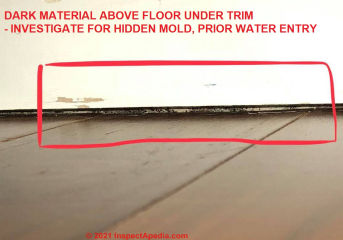 @Anonymous,
@Anonymous,
Those black marks could certainly be mold - if so then we'd be looking for more signs of building water entry or leaks;
I would use a drywall knife or utility knife to cut any paint sealing the trim boards along the board top and corner, then using a flat bar and wedges to avoid damaging the wall I'd gently loosen and pull away the trim sufficient to see its back side and to see the exposed wall surface.
If I see mold on the trim back and on the drywall behind the trim then at the very least we're going to remove the lower 6" of moldy drywall as well as the trim, replacing those with clean materials after cleaning the exposed wall cavity; on an exterior wall we'd replace any insulation that has been wet or moldy; if necessary continuing up the wall until we've reached a 6-12" margin of clean mold free materials.
If in the course of investigation we find more than 30 sq.ft. of contiguous mold it would be appropriate to stop, cover the area, and hire a professional mold remediator.
On 2021-07-02 by Anonymous
Re-posted by Moderator from private email:
found this black looking area under a baseboard (haven't pulled the baseboard off because Im afraid I may stir something up if its there) and its this gap where the floor doesnt meet with the baseboard. So I can slightly see in there. This area is less than 10 sq feet and I think I need to pull the trim off to get a better look. I am afraid of contaminating the whole room as this is a bedroom.
Any advice for proper containment? There was an old ceiling leak here and we never took off the baseboards, I think it leaked from the wall top to the ceiling down and stayed under the baseboard and on the drywall.
We replaced the roof and the ceiling where it leaked, we didnt see any water running down BEHIND the wall when we had the ceiling open. There hasn't been a leak for 6 years but I did just find what I think is mold and I think its from the time this happened. - Anonymous by private email 2021/07/01
On 2021-04-23 - by (mod) -
@Brandon,I'm close to stumped;
The fact that we see two colours is an argument for mold or mold and yeast; but the pattern is rather odd - as if the surface was swept with something.
IF you can smear away the material with a paper towel and a bit of spray cleaner, it's probably mold or a deposit of something else.
If you're certain there's no chance of moisture inside the wall cavity, try cleaning this off and waiting to see what happens.
Else I'd make a test cut to explore the wall cavity.
On 2021-04-23 by Brandon
Any idea what this is? Is it mold? The pattern is strange. It's in a closet with a bathroom on the other side but no leaks anywhere that I can see.
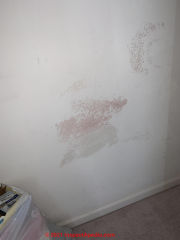
On 2021-03-27 by Lin
thank you very much!
On 2021-03-26 - by (mod) -
@Lin, those photos are not diagnostic and can simply be common house dust and spiderwebs.At lower left in the photo I think I see think black material that could be fungalhyphae;
However if you have had Leaks in your building then it is perfectly appropriate to have it inspected for both physical and hidden reservoirs of harmful mold.
See the advice given at MOLD / ENVIRONMENTAL EXPERT, HIRE ? https://inspectapedia.com/sickhouse/IAQ_Investigation.php
On 2021-03-26 by Lin
Me again, and I’m worried I have the basketball mold syndrome, but every stack in the building is leaking, there are termites and rot nearly everywhere; I take thousands of pics to document, but sometimes my eyes hurt and I’m not mycologists, I Was an opera singer.
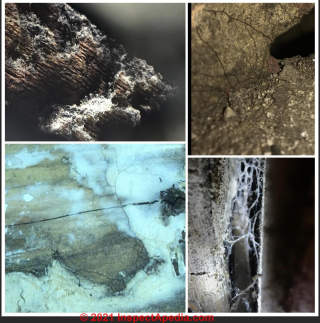
On 2021-03-24 - by (mod) -
@Lin, that black stuff looks like mold;What you see may be the indicator of a larger hidden mold reservoir on the other side of the wall covering - the details show a history of significant water entry;
It's worth exploring the wall cavity; and wearing appropriate protective gear to avoid breathing moldy dust or getting it into your eye.
On 2021-03-23 by Lin
algae makes a lot of sense. It’s nuts in this building. This is below me. Is this as bad as I think it is? About the size of my face and smells to high Heaven.
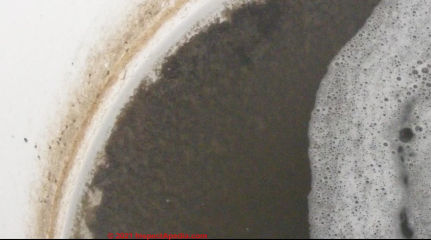
On 2021-03-23 by (mod)
@Lin, correct me if I've misunderstood the situation, but it looks as if there is a blocked drain leaving standing water in a shower pan.
If the shower backup remains for some time as a puddle in an un-used shower it'd be no surprise to see both some organic deposits (soap scum, skin cells, hair) and possibly a bit of mold growth and also algae growth in that wet area and around its edges.
On 2021-03-23 by Lin
Dear Mod,
Thanks for the answer a few years back. Tip of the iceberg. What’s all happening here? My bathtub/shower has been basically standing grey water from the tenants above since last November and now it’s got “fuzz” in it. Did some of the moldy plaster that fell in grow itself a bathtub full of itself?
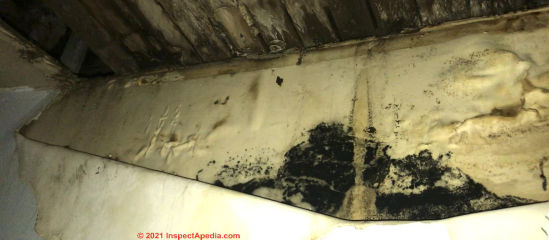
On 2021-02-25 by (mod)
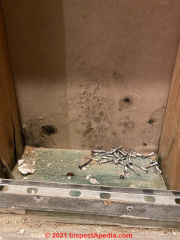 Yes your photo does look show mold;
Yes your photo does look show mold;
"Toxic" is a bit of a broad term for mold: mold may be allergenic, pathogenic, or "toxic" - each of those can have different medical effects; a more general term is "potentially harmful" or "a potential or serious health hazard" -
adding that the risks are greater for people who are themselves at extra risk, such as
Asthmatics
People with mold allergies
People with compromised immune systems
People suffering from any respiratory illness including those associated with the COVID-19 Coronavirus pandemic
The elderly
Infants
The risk level depends as well on the exposure: the amount of mold present and the duration of exposure, well as the presence or absence of high levels of harmful airborne mold spores or MVOCs (gases emitted by some indoor mold growths).
More than 30 sq.ft. or 1 square meter of contiguous moldy material usually merits professional cleaning:
Remove the mold
Clean the Exposed Surfaces
Find and fix the cause of mold growth
On 2021-02-25 by Grace
Does this look like mold? Is it toxic? My apartment had major water leaks last week and these photo is from behind some of the walls they ripped out. [Photo above]
On 2021-02-16 - by (mod) -
@Donna C,
Yes, I apologize if my prior remarks were not clear. Small amounts of mold, less than 30 contiguous square feet, can be cleaned off by a handyman or even a homeowner using ordinary household cleaners.
I suggested in my previous remark that in addition to cleaning off the mold you can see, it's worth making sure that that's the only problem in the flat.
On 2021-02-16 by Donna C
Thank you for your prompt reply. The photo is actually sideways. If you can see the top of a hanger that is the bottom of the top shelf where the mold is. It is the top left corner inside a larger wardrobe closet. The area where the mold is is drywall.
There is not much space for storage otherwise but she can keep from storing anything on that shelf. Doctor visit was inconclusive, but she is to go back if she feels worse. Given that this mold is in a closet in the bedroom we are concerned that she may be breathing in potentially dangerous mold spores. Should she clean off the mold and then cover that part of the closet with a towel or plastic today until the problem can be addressed. A
re you are inclined to think that she should contact her landlady about having the problem investigated further. Thank you again for any suggestions.
On 2021-02-16 by (mod) - mold in a London Flat
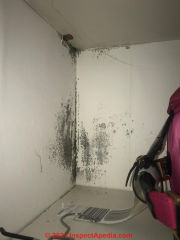 Donna
Donna
That is certainly mold contamination; it looks as if it is inside of a storage cabinet or closet.
While I have on occasion inspected and then tested environments for very low levels of airborne mold spores that nevertheless caused a reaction in someone who was hyper-sensitive,
in most cases, on viewing your photo and IF that is the only visible mold in your daughter's flat,
then the total area of what we can see is not sufficient to explain a mold-related or mold-exacerbated illness, unless someone put their finger in mold and then rubbed it in their eye or a similar sensitive area.
However given visible mold it's appropriate to inspect the London flat more carefully to form an opinion of the probability that there is a larger, perhaps more-hidden, mold reservoir that needs attention.
I recommend two articles that may help you and your daughter with this mold question:
HIDDEN MOLD, HOW TO FIND
and
MOLD / ENVIRONMENTAL EXPERT, HIRE ? discusses how to decide when it's cost-justified to bring in an actual expert
Meanwhile,
- stop storing anything in that cabinet
- remove the mold from what I take to be a hard wood-product surface using any household cleaner
On 2021-02-16 by Donna C
My daughter is a college student in London and just moved into a new apartment about a month ago. She’s been experiencing a sore throat and other mild symptoms. She noticed what looks like mold in the top of her bedroom closet (see attached photo). She said the apartment often feels very damp. She is at the doctors now to see if she has COVID or strep throat. We are worried she could be experiencing illness from mold.
The photo of the mold in her closet looks like a type of black mold. She should probably contact her landlady to fix it? But we want to be better informed first. Any advice would be appreciated. Thank you!
[Photo above]
On 2021-02-08 - by (mod) -
Robert:
You'll read at MOLD KILLING GUIDE that the "Kill the Mold" approach does not work well nor reliably, as it is never 100% effective and as it can leave "dead" mold material that is still allergenic or toxic.
In sum the proper approach is
- remove the mold
- clean the exposed surfaces of the wood
- fix the cause of its growth
- optionally: seal the wood to reduce future moisture uptake and thus make it less mold-friendly
Leaving your vinegar-treated, pressure-washed, mold-stained boards un-sealed isn't a crime, as I argue that all mold is everywhere all the time (J. Jaines) and that it's local conditions, principally moisture, also temperature, that spur new mold contamination growth on indoor surfaces;
But pre-inoculated wood that still contains a dose of mold might give a boost-up to new mold growth if the wood is exposed to moisture;
Ultimately we might wonder if the cost and trouble are worth the end result in this particular case and approach -that's just an OPINION
On 2021-02-08 by Robert Nelsen
@Robert Nelsen’s
As far as symptoms go I don’t go in shop much.headache is wherever I go shop has two 9x10 doors usually open weather permitting. As for construction 1x4 attached to ‘2x8 insulation between. Has ridge vent plenty of windows .
no leaks.I’m thinking putting reclaimed wood in wall & fire place with floating beam this time I think I’ll pressure wash then spray with vinegar.but it takes away the patina.
in this photo you can see the difference.thank you for your quick response.& advise i think I will seal shop .
Boards on left are treated boards on right aren’t they are still wet
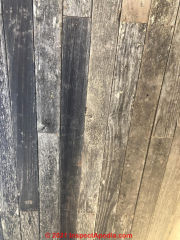
On 2021-02-07 - by (mod) -
Darn Robert, I was sure I replied to your photo and question earlier but don't see my answer.
Oh! That's because you posted the same question and I replied at
https://inspectapedia.com/mold/Cosmetic_Black_Mold.php BLACK MOLD, HARMLESS
I repeat here (where this conversation fits-better) what I said there:
Most likely that blackening is a mold that, outdoors, would be harmless but indoors, even if it's simply a species of Cladosporium - the most-common outdoor mold genera, it may be at least allergenic.
Sometimes a mold present on a surface is so happy it doesn't release significant levels of MVOCs nor spores until its environment changes. I watched very moldy books in a library go from releasing almost nothing into the air to releasing thick clouds of Aspergillus sp. spores within hours of turning on commercial dehumidifiers and air machines.
There area some options to try before a tear-out, depending on the urgency of the situation:
- if you ventilate the room with fresh air do symptoms diminish?
- do your symptoms go away when you are away from this home or room? (this is not definitive but can be diagnostic)
- are the boards installed over a drywall ceiling? (and are we sure there are no leaks above nor other obvious indoor air quality or contaminant sources?)
If so, one might consider the option of sealing the exposed surface with a low VOC polyurethane or similar clear sealant in a flat finish; that would substantially reduce offgassing and spore release.
On 2021-02-07 by Robert Nelsen
Here is pic of previous post for got to post picture
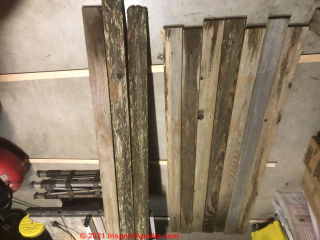
I built a shop five years ago I used reclaimed fencing for ceiling. I did ceiling in summer lumber was dry ,but some boards had black on them . They look the same now as they did then .I have bed room above ceiling/stayed up their a few months .
Around that time I started to get consistent daily head aces.doctors can’t figure it out. I. Haven’t been up there for months. Still have daily headaches. Wife wants to put reclaimed wood inside house. But need to know if it’s safe thanks
On 2021-01-29 by (mod) hairy stuff on wall - probably not mold
Hateful:
When I click and enlarge your photo I see what looks like a mix of house dust and hair.
On 2021-01-29 by ihatetwhite
Heres another photo of stuff I'm worried is toxic mold
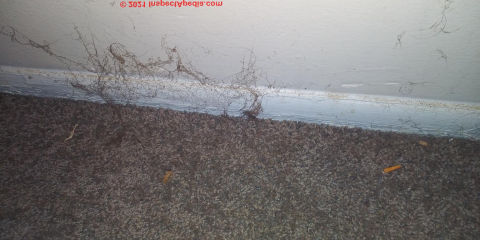
Question: can you identify this black mold or lichens?
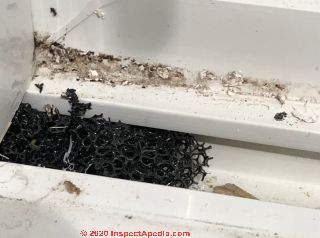 We recently discovered what looks to be some sort of mold/moss/lichen in window jambs located in our bedroom, bathrooms and kitchen. Please see attached photo. I would describe it as something that looks like black algae or moss or similar.
We recently discovered what looks to be some sort of mold/moss/lichen in window jambs located in our bedroom, bathrooms and kitchen. Please see attached photo. I would describe it as something that looks like black algae or moss or similar.
We are emailing around to see if a professional can readily identify the type of mold based on this photo. So far we have had no success and so were hoping you may know.
We are obviously very concerned about the health risks this may pose and so were hoping to identify this to understand what we are dealing with.
The exact same thing was found in each of the 4 window jambs in the rooms described above and was previously hidden by a plastic tab that has been removed for the purpose of the photo.
Can you please identify for us what this mold/moss/lichen this is? Is it toxic black mold or some other type of mold? Do you know if this is toxic or dangerous? - Anonymous by private email 2020/12/18
Moderator reply: is it mold? Lichens? Something else?
I'm sorry but I don't recognize the black material in your photo. It looks as if it's the fruiting body of a fungus but I agree it might be a lichens or even something else.
I have asked an expert mycologist if he recognizes this material as a fungus or as something else and will post that reply here.
In any event the total volume of it is itself absolutely trivial and would be removed by normal cleaning methods. Trivial means it's not a measurable health risk.
Watch out: However when you see a fungus growing in a windowsill you need to consider that there may have been a leak into the wall below where there could be a larger and more significant hidden mold reservoir or other water-related damage such as rot or insect attack.
Therefore you need to identify and fix the source of the leak that fed this growth and you should consider making a modest or small exploratory opening to check the wall cavity below for mold or other damage.
Reader follow-up: I think this is plastic, not mold
After some more research, we are now thinking it is not even mold. It seems the previous owners placed some sort of construction material in these window sills.
"Reticulated Polyurethane 10 ppi"
What do you think?
Moderator reply: open plastic materials not useful as building insulation
I wondered if it wasn't organic at all -
another reader recently shared a photo of some plastic shards that someone had planted in his attic as "insulation" that we discuss
at
INSULATION IDENTIFICATION GUIDE
(search that page for "shredded plastic insulation" to see details)
It ought to be trivial to look at the material more-closely, pull it apart, and perhaps to send me a sharper close-up photo or two of what you've got.
In my opinion the material in your photos, if it's plastic such as the recycled polyurethane sheets (from Merryweather Inc. for example) is entirely ineffective as an insulation material for use in buildings.
On 2021-01-27 by danjoefriedman (mod)
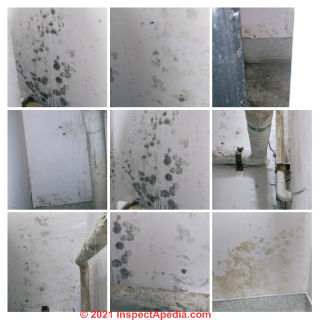 Jenny
Jenny
To invite expert comment and to preserve this conversation I will copy it and respond in detail at
DEFINITION of MOLD EMERGENCY
Please take a look there and do not hesitate to post further questions, comments, opinions; if you have concerns that can not be made public you can also send private email using the page top or bottom CONTACT link that will reach me directly
Please keep me posted.
On 2021-01-27 by Jenny
Hello, I was recently assigned to a "drywall repair" job inside a medical dialysis center. The precise location of this repair was in what I like to call the 'boiler room' where the one & only water heater is housed.
I'm not exactly sure of the required room size per size of water heater but it seemed like this room was entirely to small for starters & one small inadequate vent.
Anyway, when I 1st arrived on site I immediately noticed the large amounts of condensation on the ceiling & puddles on the floor. I completed the wall portion of the drywall repair & left.
By the next day when I got there, it was full on raining inside this tiny room, from above the ceiling & coming thru a large opening that needed the repair. & two more 'bubbles/swells' had developed on the ceiling.
Needless to say, the water leak had to be fixed first. So I punctured a couple holes in the water bubbles to relieve the build-up from above it. Not sure how long this water leak had been getting worse for but I then noticed what appeared to be black mold growing on at least 2 of the 3 walls.
I'm attaching the photos I took.
On 2020-12-05 - by (mod) - few molds found on indoor surfaces that are harmless.
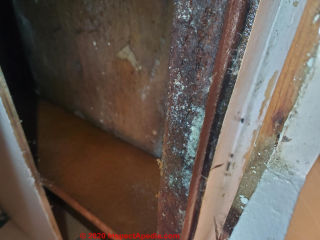 There are very few molds found on indoor surfaces that are harmless.
There are very few molds found on indoor surfaces that are harmless.
If you use the on page search box to search for COSMETIC MOLD you will find there are two dark colored molds that sometimes come in on framing lumber and that are easily distinguished by their growth patterns.
But light green, gray, white molds like those in your photo are not cosmetic.
Such mold may be allergenic or it may pose more serious pathogenic or toxic hazards depending on the health-vulnerability of building occupants.
When there is or has been active mold growth on a building surface you should treat it as harmful and it should be removed, the surface cleaned, and it's cause corrected.
On 2020-12-05 by Ben
Does this mold look like it could be toxic mold? [Photo above]
On 2020-10-18 - by (mod) -
Keep me posted, maybe post a photo or two of what you find - that may permit further arm-waving.
On 2020-10-18 by Jon
Thanks a lot, Dan! That’s great to hear. I’ll get on top of that ASAP. :)
On 2020-10-18 - by (mod) -
That's definitely a water leak stain;
the brown may be leaching from some non-fungal source behind that insulation, so merits a closer look:
 On further investigation, possible IMO only by removing some of the insulation, you'll want to know where the water is coming from; is it from outside - or from moisture accumulating from air leaking into and trapping condensate behind that vapor barrier.
On further investigation, possible IMO only by removing some of the insulation, you'll want to know where the water is coming from; is it from outside - or from moisture accumulating from air leaking into and trapping condensate behind that vapor barrier.
Wet insulation needs to be removed,
the exposed surfaces inspected for mold, & cleaned,
the cause of leakage fixed
new insulation installed
new vapor barrier installed
If this were my home and if the leaks are traced to an outdoor source I would not re-insulate before having
1. fixed the leak source
2. gone through a full year of seasons to be absolutely confident that there is no more leakage
since otherwise we risk having to do this all over again
On 2020-10-18 by Jon
Thank you for the reply... it’s actually all around the basement, sometimes more severe in some places and like the corner in others.
It’s within the first year, so I’d imagine it’s something that’d be handled by warranty.
I assume that regardless, the fibreglass needs to be redone?
On 2020-10-18 - by (mod) -
I see what looks like a water stain and possibly water and possibly mold.
If I am correct them I recommend that we go to the most suspect or worst looking spot and cut that area open to inspect the wall in that area to find the nature and source of leakage.
If you have fibreglass insulation that is wet then it's going to need to be removed.
On 2020-10-18 by Jon
Hi, I have fibreglass insulation behind a vapour barrier in my newbuild’s basement [photo above].
The basement has a dehumidifier keeping humidity to 50% or lower, but all around the basement the insulation looks like this now.
Is that mould?
On 2020-06-24 by (mod) - is this black mold on concrete or something else?
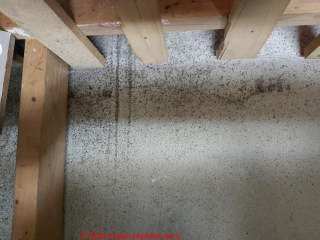 It does look like mold but I can't be sure with just the data in your photo;
It does look like mold but I can't be sure with just the data in your photo;
Indeed mold can grow on concrete, though usually it's actually feeding on organic dust or debris or paint on that surface.
Is there water or high moisture?
Is there mold growth on wood nearby? I think I see light coloured mold on some of th boards at the top of your photo.
What do other surfaces in the same area look-like?
On 2020-06-21 by Scott
Hello, I'm trying to determine if the following picture is mold on concrete or some other kind of staining. For context:
I live in a 60 year old house with concrete foundation in Southwestern Ontario.
This photo is in the basement utility room. Previous owner divided the room with a partition wall so there isn't great air circulation without a fan, and the basement is fairly humid. Our dehumidifier wasn't working st the start of the warm weather and in the pandemic I was slow getting around to it. I noticed that a historical spot of efflorescence in the room was "growing" and that got me moving to get a dehumidifier working in the space again. This area is also home to a cat litter box, so it's subject to higher than normal amounts of dust.
I'd welcome any insight and can also can provide a couple other photos. A white efflorescence streak extends the length of the entire adjacent wall, and I'd be curious for insight on why that area might be subject to increased moisture (a function of the lack of air circulation?)
Thank you,
Scott
On 2020-06-24 - by (mod) - Probably black mold on concrete foundation wall & light mold on wood nearby
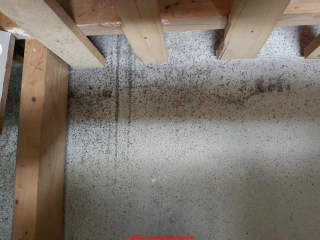 It does look like mold but I can't be sure with just the data in your photo; Is there water or high moisture? Is there mold growth on wood nearby? What do other surfaces in the same area look-like?
It does look like mold but I can't be sure with just the data in your photo; Is there water or high moisture? Is there mold growth on wood nearby? What do other surfaces in the same area look-like?
I think I see light coloured mold on some of the horizontal wood boards at the top of your photo. That would argue for mold growth in this area and a dampness or water entry problem as well.
[Click to enlarge any photo]
Also see the example photos (and yours)
at MOLD on CONCRETE, STONE, or MASONRY Surfaces
On 2020-06-21 by Scott
Hello, I'm trying to determine if the following picture is mold on concrete or some other kind of staining. For context:
I live in a 60 year old house with concrete foundation in Southwestern Ontario.
This photo is in the basement utility room.
Previous owner divided the room with a partition wall so there isn't great air circulation without a fan, and the basement is fairly humid.
Our dehumidifier wasn't working st the start of the warm weather and in the pandemic I was slow getting around to it. I noticed that a historical spot of efflorescence in the room was "growing" and that got me moving to get a dehumidifier working in the space again.
This area is also home to a cat litter box, so it's subject to higher than normal amounts of dust.
I'd welcome any insight and can also can provide a couple other photos. A white efflorescence streak extends the length of the entire adjacent wall, and I'd be curious for insight on why that area might be subject to increased moisture (a function of the lack of air circulation?)
Thank you,
Scott
On 2020-03-13 - by (mod) - mold near leaky toilet
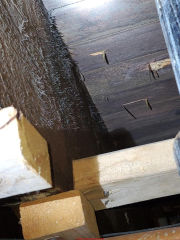 It is very strange looking and doesn't resemble a fungus that I've seen.
It is very strange looking and doesn't resemble a fungus that I've seen.
But there is so much very dark wood sheathing or subfloor that I suspect that there is mold growth on both framing and other wood surfaces in your photo.
On 2020-03-13 by Robert Scott
Leaky toilet went unnoticed. When I pulled the dry wall from the ceiling (black mold or mildew specks) the rafter adjacent to the sewer pipe had these black spikes growing.
At first I thought it was damage to the wood from construction
(100 yo bldg restored 20 yrs ago)
Maybe abrasion from installation of the sewer and plumbing torch.
And I honestly cant tell if they're splinters off the wood or growth. T
hey look so uniform that I'm worried it might be mold or fungus.
On 2019-08-24 - by (mod) -
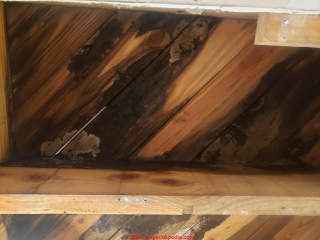 Jim
Jim
That looks like several kinds of mold; you need to
1. be sure that any leaks from above are already fixed
2. probe the wood to find out if it's so rotted that it needs replacement
3. Use any household cleaner to clean the surface - spray and paper towels or rags are ok for a small cleanup area like this - spray, wipe, throw the wipes in the garbage;
4. If there's no actual rot or repair needed, you might optionally spray the surfaces with clear shellac or lacquer to reduce future moisture-uptake, OR you can search InspectApedia.com
for FUNGICIDAL SEALANT USE GUIDE for other options.
On 2019-08-24 by JimC72
Two story 40 year old home in North Florida.This is in the floor above a bedroom closet under a bathroom. Source of water damage was a leaking toilet tank to bowl bolt that went unnoticed for several months.
Dicovered and exposed in May, treated undiluted vinegar spray and box fan twice, without wiping. Has remained exposed (closet ceiling removed and door opened). Is less than 10 sq ft. Looking for Remediation ideas
On 2019-08-14 - by (mod) -
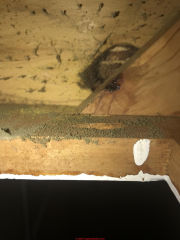 Lin that's a thick mold contamination, perhaps a species of Aspergillus or Trichoderma (though there are other green moulds common in that location such as Trichoderma).
Lin that's a thick mold contamination, perhaps a species of Aspergillus or Trichoderma (though there are other green moulds common in that location such as Trichoderma).
You should avoid breathing those spores as they can be harmful.
If I were cleaning up this mold, because it's easily airborne, I'd wear a HEPA respirator, eye protection, etc.
and I'd be sure, after cleanup, to thoroughly ventilate the room with fresh air.
Wet the area carefully using a household cleaner, remove the mold, fix the leak that caused it.
DO NOT run a conventional home vacuum cleaner as you'll just increase the airborne mold level.
On 2019-08- by Lin
I found this under the kitchen counter where the drawer pulls out.
It smells rank and I thought it was dust bunnies, but it has very uniform round bits.
Anyone?
On 2019-08-10 - by (mod) -
Tim:
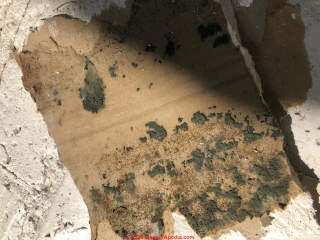 Thanks for the question and photo, Tim.
Thanks for the question and photo, Tim.
1. No one can for-sure identify your mold from the photo alone, though common molds of that appearance and in that location might be a species of Aspergillus or a Trichoderma - it's greenish so I rule out Stemonitis that otherwise can look like that.
2. Worry about "black mold" is a terrible dis-service done to the public by some writers and reporters. To say that "black mold" is the only or even most-harmful mold in buildings is simply dead wrong. Harmful mold may be of any color or texture.
3. We don't need to know the genera/species of this mold to know what to do: the species won't change the cleanup procedure one bit.
4. You'll need to follow the water, remove all drywall that was ever wet, clean the exposed surfaces, fix the leak, repair the building.
IF the total area of contiguous mold is 30 sqft or more then professional remediation is probably in order.
PS: If I were to guess I'd opt for a species of Trichoderma or a species of Aspergillus in your photo; but the genera/species of mold won't change what action is needed.
On 2019-08-09 by Tim
Hey guys. I had an AC issue that led to water flowing down a wall and into the crawlspace.
It came to my attention when I started to notice a smell in the wall that I would have associated with algae in a creek.
Even weeks after the leak has been fixed. No one else could smell is and there were no visible signs of mold. I finally cut open the drywall from floor to ceiling and found this growth on the inside surface
It's dark green and very powdery like a fine dust. I've read that black mold has a slime coating on it.
Hoping it's not that, but I'm having trouble finding photos of any mold that look like this. Hoped I could get some help identifying it here. Thanks
On 2019-09-19 - by (mod) -
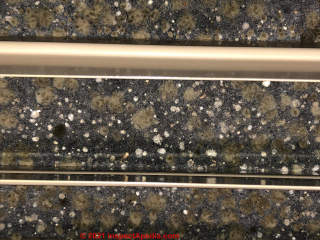 The pattern of light and gray dots looks quite a bit like mold growth.
The pattern of light and gray dots looks quite a bit like mold growth.
I'm a little confused: filters on an "outflow" vent? I assume you mean you have filters in your air supply registers - which is a bit odd; usually we filter on the inlet end of the system so as to avoid crudding up the air handler, blower fan, ductwork.
Anyway I would
1. remove and clean the vent grille - any household spray cleaner is fine, then rinse and dry.
2. replace your air filters
3. Take a look at the air handler and blower to see that they're clean
4. Look for an abnormal moisture source: mold likes to grow on organic material - that includes house dust deposits on your registers - but won't grow worth mentioning without moisture
5. Don't waste money testing: knowing the genera/species orf mold won't change the cleanup needed
On 2019-09-19 by Bob
Good afternoon. Found this on the back side of filters in an HVAC outflow vent (ie, hit by cold air coming into the room). I've read here that probably need microscopic examination to identify, but just in case...
I don't see any mold growth in the ducts below this vent grill. How "seriously should I take this?
On 2018-12-28 - by (mod) -
Dark fuzzy mold in many round colonies - could be any of quite a few genera/species including some species of Aspergillus sp. Relevant is what it's growing on. On books some species of Aspergillus are common.
Watch out: with just a few exceptions the identity of most mold colonies on surfaces can't be made reliably by eye and requires microscopic examination.
And knowing the mold genera/species makes not one iota of difference in the remedy required.
See more information at BOOK / DOCUMENT MOLD & WATER DAMAGE RESTORATION
That article series discusses dealing with moldy books and possible health concerns.
On 2018-12-28 by Linda
What kind of mold does this look like?
IMAGE LOST by older version of Clark Van Oyen’s Comments Box code - now fixed. Please re-post the image if you can. Sorry. Mod.
On 2018-09-21 - by (mod) -
Brock
Looks like mold but the photo is too blurry to offer a confident reply.
Spraying or painting over mold - IF that was done to a large (more than 30 sqft.) mold reservoir - is ineffective and improper.
Mold needs to be removed, the surfaces cleaned, the cause fixed.
On 2018-09-20 by Brock paggen
I have a little girl and I'm worried about her in my house i rent. I just moved in 2 months ago and i noticed a bottle of mold cleaner by the area where a dishwasher used to be.
The house looks as if it got flooded at some point and there is black stuff on the walls in the area. I just want to know if it's mold or not as i believe it is. Ive asked my landlord since day 1 about removing this mold but haven't heard a thing back except that they will paint over it. Im not ok with it nor am i ok with risking my girls health. Im not a person to get a lawyer and go to court but if my girl has a cough from this and it was known by them then I'm going to be pissed.
Any help you can give me
IMAGE LOST by older version of Clark Van Oyen’s Comments Box code - now fixed. Please re-post the image if you can. Sorry. Mod.
...
Continue reading at MOLD APPEARANCE - WHAT MOLD LOOKS LIKE - topic home, or select a topic from the closely-related articles below, or see the complete ARTICLE INDEX.
Or see these
Recommended Articles
- MOLD APPEARANCE - STUFF THAT IS NOT MOLD
- MOLD APPEARANCE on VARIOUS SURFACES photo guide to what mold looks like growing on more than 100 different building surfaces
- MOLD APPEARANCE - WHAT MOLD LOOKS LIKE - what toxic black mold or other indoor mold looks like in buildings.
- MOLD ATLAS & PARTICLES INDEX atlas of building molds and microphotographs of mold samples observed in the laboratory
- MOLD RELATED ILLNESS SYMPTOMS Index of Symptoms
Suggested citation for this web page
MOLD APPEARANCE FAQs at InspectApedia.com - online encyclopedia of building & environmental inspection, testing, diagnosis, repair, & problem prevention advice.
Or see this
INDEX to RELATED ARTICLES: ARTICLE INDEX to MOLD CONTAMINATION & REMEDIATION
Or use the SEARCH BOX found below to Ask a Question or Search InspectApedia
Ask a Question or Search InspectApedia
Try the search box just below, or if you prefer, post a question or comment in the Comments box below and we will respond promptly.
Search the InspectApedia website
Note: appearance of your Comment below may be delayed: if your comment contains an image, photograph, web link, or text that looks to the software as if it might be a web link, your posting will appear after it has been approved by a moderator. Apologies for the delay.
Only one image can be added per comment but you can post as many comments, and therefore images, as you like.
You will not receive a notification when a response to your question has been posted.
Please bookmark this page to make it easy for you to check back for our response.
IF above you see "Comment Form is loading comments..." then COMMENT BOX - countable.ca / bawkbox.com IS NOT WORKING.
In any case you are welcome to send an email directly to us at InspectApedia.com at editor@inspectApedia.com
We'll reply to you directly. Please help us help you by noting, in your email, the URL of the InspectApedia page where you wanted to comment.
Citations & References
In addition to any citations in the article above, a full list is available on request.
- In addition to citations & references found in this article, see the research citations given at the end of the related articles found at our suggested
CONTINUE READING or RECOMMENDED ARTICLES.
- Carson, Dunlop & Associates Ltd., 120 Carlton Street Suite 407, Toronto ON M5A 4K2. Tel: (416) 964-9415 1-800-268-7070 Email: info@carsondunlop.com. Alan Carson is a past president of ASHI, the American Society of Home Inspectors.
Thanks to Alan Carson and Bob Dunlop, for permission for InspectAPedia to use text excerpts from The HOME REFERENCE BOOK - the Encyclopedia of Homes and to use illustrations from The ILLUSTRATED HOME .
Carson Dunlop Associates provides extensive home inspection education and report writing material. In gratitude we provide links to tsome Carson Dunlop Associates products and services.


